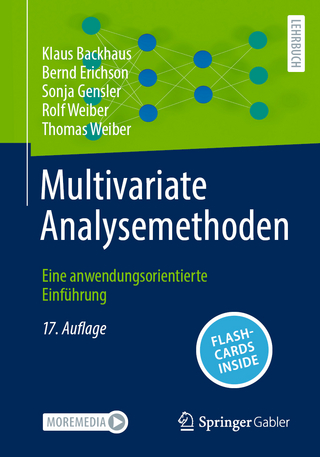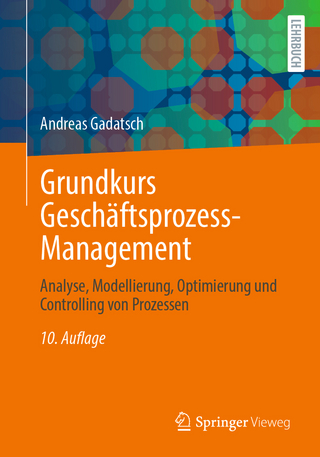
Business Statistics Plus NEW MyLab Statistics with Pearson eText -- Access Card Package
Pearson (Verlag)
978-0-13-386500-4 (ISBN)
- Titel erscheint in neuer Auflage
- Artikel merken
Packages
Access codes for Pearson's MyLab & Mastering products may not be included when purchasing or renting from companies other than Pearson; check with the seller before completing your purchase.
Used or rental books
If you rent or purchase a used book with an access code, the access code may have been redeemed previously and you may have to purchase a new access code.
Access codes
Access codes that are purchased from sellers other than Pearson carry a higher risk of being either the wrong ISBN or a previously redeemed code. Check with the seller prior to purchase.
Robert Donnelly’s Business Statistics eliminates the intimidation factor from learning statistics for business. The Second Edition maintains Donnelly’s successful straightforward, conversational approach that explains each concept and why it is important directly to students. Through an abundance of comments that clarify specific topics, a variety of applications, and Your Turn practice throughout each chapter, students see business statistics in action—both in the classroom and in the world around them.
0133865002/9780133865004 - Business Statistics Plus NEW MyStatLab with Pearson eText -- Access Card Package, 2/eThis Package Contains
032192147X/9780321921475 - MyStatLab for Business Statistics -- Glue-In Access Card, 1/e
0321925122/9780321925121 - Business Statistics, 2/e
0321929713/9780321929716 - MyStatLab for Business Statistics Sticker, 1/e
Bob Donnelly is a professor at Goldey-Beacom College in Wilmington Delaware with more than 25 years of teaching experience. He teaches classes in statistics, operations management, management information systems, and database management at both the undergraduate and graduate level. Bob earned an undergraduate degree in chemical engineering from the University of Delaware, after which he worked for several years as an engineer with the Diamond Shamrock Corporation in a chlorine plant. Despite success in this field, Bob felt drawn to purse a career in education. It was his desire to teach that took him back to school to earn his MBA and Ph.D. in Operations Research, also from the University of Delaware. Bob also teaches in the MBA program at the International School of Management in Paris, France. He thoroughly enjoys discussing research methods and business statistics with both his French and American students. Bob’s working experience gather prior to his teaching career has provided him with many opportunities to incorporate real-life examples into classroom learning. His students appreciate his knowledge of the business world as well as his mastery of the course subject matter. Many former students seek Bob’s assistance in work-related issues that deal with this expertise.
Preface
Acknowledgments
Dear Students
1. An Introduction to Business Statistics
1.1 Business Statistics and Their Uses
1.2 Data
1.3 Descriptive and Inferential Statistics
1.4 Ethics and Statistics—It’s a Dangerous World of Data Out There
2. Displaying Descriptive Statistics
2.1 The Role Technology Plays in Statistics
2.2 Displaying Quantitative Data
2.3 Displaying Qualitative Data
2.4 Contingency Tables
2.5 Stem and Leaf Display
2.6 Scatter Plots
3. Calculating Descriptive Statistics
3.1 Measures of Central Tendency
3.2 Measures of Variability
3.3 Using the Mean and Standard Deviation Together
3.4 Working with Grouped Data
3.5 Measures of Relative Position
3.6 Measures of Association Between Two Variables
4. Introduction to Probabilities
4.1 An Introduction to Probabilities
4.2 Probability Rules for More Than One Event
4.3 Counting Principles
5. Discrete Probability Distributions
5.1 Introduction to Discrete Probability Distributions
5.2 Binomial Distributions
5.3 Poisson Distributions
5.4 The Hypergeometric Distribution
6. Continuous Probability Distributions
6.1 Continuous Random Variables
6.2 Normal Probability Distributions
6.3 Exponential Probability Distributions
6.4 Uniform Probability Distributions
7. Sampling and Sampling Distributions
7.1 Why Sample?
7.2 Types of Sampling
7.3 Sampling and Nonsampling Errors
7.4 The Central Limit Theorem
7.5 The Sampling Distribution of the Proportion
8. Confidence Intervals
8.1 Point Estimates
8.2 Calculating Confidence Intervals for the Mean when the Standard Deviation (σ) of a Population Is Known
8.3 Calculating Confidence Intervals for the Mean when the Standard Deviation (σ) of a Population Is Unknown
8.4 Calculating Confidence Intervals for Proportions
8.5 Determining the Sample Size
8.6 Calculating Confidence Intervals for Finite Populations
9. Hypothesis Testing for a Single Population
9.1 An Introduction to Hypothesis Testing
9.2 Hypothesis Testing for the Population Mean When σ Is Known
9.3 Hypothesis Testing for the Population Mean when σ Is Unknown
9.4 Hypothesis Testing for the Proportion of a Population
9.5 Type II Errors
10. Hypothesis Tests Comparing Two Populations
10.1 Comparing Two Population Means with
10.2 Comparing Two Population Means with
10.3 Hypothesis Testing With Dependent Samples
10.4 Comparing Two Population Proportions with Independent Samples
11. Analysis of Variance (ANOVA) Procedures
11.1 One-Way ANOVA: Examining the Effect a Single Factor Has on the Means of Populations
11.2 Randomized Block ANOVA: Examining the Effects of a Single Factor by Blocking a Second Factor
11.3 Two-Way ANOVA: Examining the Effects Two Factors Have on the Means of Populations
12. Chi-Square Tests
12.1 Comparing Two or More Population Proportions
12.2 Determining If Observed Frequencies Follow a Known Probability Distribution
12.3 Testing the Independence of Two Variables
13. Hypothesis Tests for the Population Variance
13.1 Testing the Variance of a Single Population
13.2 Comparing the Variances of Two Populations
14. Correlation and Simple Linear Regression
14.1 Dependent and Independent Variables
14.2 Correlation Analysis
14.3 Simple Linear Regression Analysis
14.4 Using a Regression to Make a Prediction
14.5 Testing the Significance of the Slope of the Regression Equation
14.6 Assumptions for Regression Analysis
14.7 A Simple Regression Example with a Negative Correlation
14.8 Some Final (but Very Important) Thoughts
15. Multiple Regression and Model Building
15.1 Developing the Multiple Regression Model
15.2 Explaining the Variation of the Dependent Variable
15.3 Inferences about the Independent Variables
15.4 Using Qualitative Independent Variables
15.5 Model Building
16. Forecasting
16.1 Introduction to Forecasting
16.2 Smoothing Forecasting Methods
16.3 Forecasting with Regression Analysis
16.4 Forecasting with Seasonality
17. Decision Analysis
17.1 Introduction to Decision Analysis
17.2 Constructing a Decision Table
17.3 Decision Making Under Uncertainty
17.4 Decision Making Under Risk
17.5 Decision Making Using Decision Trees
17.6 Using Bayes’ Theorem to Calculate Posterior Probabilities
18. Nonparametric Statistics
18.1 Introduction to Nonparametric Statistics
18.2 The Sign Test
18.3 The Wilcoxon Rank-Sum Test for Two Independent Samples
18.4 The Wilcoxon Signed-Rank Test for Two Dependent Samples
18.5 The Kruskal-Wallis One-Way ANOVA
18.6 The Spearman Rank-Order Correlation Coefficient
Appendix A
Table 1 Binomial Probabilities
Table 2 Poisson Probabilities
Table 3 Cumulative Probabilities for the Standard Normal Distribution
Table 4 Cumulative Probabilities for the Standard Normal Distribution
Table 5 Student’s t-distribution
Table 6 F-distribution
Table 7 Critical Values of the Studentized Range, Q
Table 8 Chi–Square Distribution
Table 9 Critical Values for the Durbin-Watson Statistic
Appendix B: Answers to Selected Even-Numbered Problems
Index of Applications
Index
| Sprache | englisch |
|---|---|
| Maße | 224 x 282 mm |
| Gewicht | 2100 g |
| Themenwelt | Mathematik / Informatik ► Mathematik ► Finanz- / Wirtschaftsmathematik |
| Mathematik / Informatik ► Mathematik ► Statistik | |
| Wirtschaft ► Betriebswirtschaft / Management | |
| ISBN-10 | 0-13-386500-2 / 0133865002 |
| ISBN-13 | 978-0-13-386500-4 / 9780133865004 |
| Zustand | Neuware |
| Haben Sie eine Frage zum Produkt? |
aus dem Bereich



